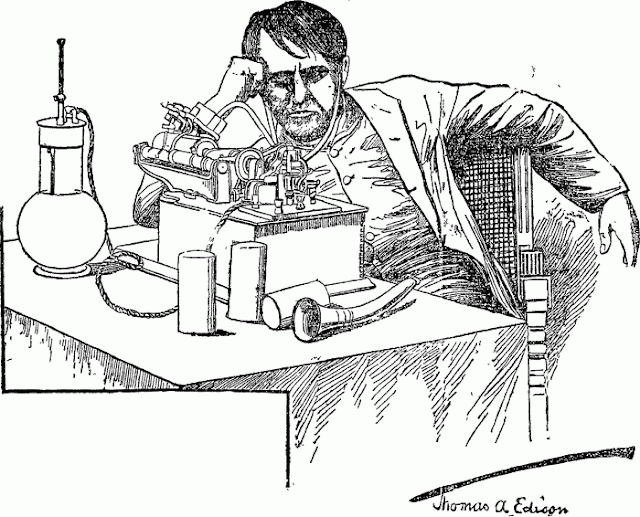 |
| Thomas Edison receiving the first Phonographic Message from England, Auckland Star, 07 February 1891 Image courtesy of Papers Past |
Thursday, 28 November 2013
On this day in 1892
Sunday, 24 November 2013
On this day in 1897
 |
| Kinematograph projector Image courtesy of George Eastman House Technology Archive |
Friday, 22 November 2013
Bowling was in vogue in Tauranga years ago
 |
| Lawn bowl and Bowling stone, Tauranga Heritage Collection |
These stone balls have only been found in the Tauranga and Mount Maunganui areas in New Zealand. This example is made of a soft, coarse grained stone - probably a local volcanic rhyolite - 8.5 to 13.5 cm in diameter and weighing 2.52 kg.
Throughout the last 150 years various collectors of Maori artefacts have come across these spherical shaped stones and deposited them in museums for safe-keeping. People are now able to research and document these artefacts, but more importantly it enables us to form an appreciation of, and an insight into, the lives of past cultures and possibly their pastimes, while appreciating the rarity of such taonga throughout New Zealand.
Edward Earl Vaile was a collector who donated 14 bowling stones and 11 pumice bowls, all found at Mount Maunganui and Motuhoa Island, to the Auckland War Memorial Museum. Vaile was born on 3rd March 1864 at Hampstead, London, England, and educated at Auckland College and Grammar School. In 1886 he joined the family real estate business and was asked to give his advice on the value of an estate of undeveloped pumice land between Rotorua and Taupo. Around this point Vaile retired from the family business and became a farmer. He also had an interest in philanthropy and endowed the archaeologist’s position at Auckland Museum.
Despite the availability of these objects for research purposes, mysteries remain such as why the stones are limited to one locality? Are there any links between these stones and those of the Pacific Island nations? Were they imported here or locally manufactured? Were they used to establish who the top athlete was, or simply part of a game to pass the time?
Friday, 15 November 2013
Mount Drury
 |
| Mount Drury from Moturiki (Photo courtesy of Fiona Kean & Charlie Colquhoun) |
 |
| Mount Drury from Moturiki (Photo courtesy of Tauranga Heritage Collection) |
Friday, 8 November 2013
The Silk Three-quarter Coat
The coat pictured is made of black silk, and lined with the same fabric. By its size, I would assume that this garment was made for Mrs Brain, and it is typical of the 30’s style when garments of fur, or decorated with fur, were very fashionable.
It is entirely hand made, with the maker using every scrap of fabric to complete the lining. evidence of this is all the hand stitching evident on the inside. The coat has a padding of some description to give it warmth, as it was possibly made for eveningwear. Without undoing a seam, I have not been able to identify the material used; it makes the coat quite heavy and it would have been very cosy.
Embellished with a wide band of fur around the hem and around the sleeves, and fastened with two toggles, this evening coat would have been very smart in its time. Sadly the fur is very fragile now, and attempts to repair it had to be abandoned because it was falling apart as I tried to re-stitch to the coat.
Wednesday, 6 November 2013
On this day in 1882
 |
| Horse drawn coach and passengers, Athenree Post Office and homestead, Tauranga district, c. 1906 Image courtesy of Alexander Turnbull Library |
Credit:
Horse drawn coach alongside the Athenree Post Office and Athenree homestead, Tauranga district. Ref: 1/1-003810-G. Alexander Turnbull Library, Wellington, New Zealand. http://natlib.govt.nz/records/22606632
Saturday, 2 November 2013
On this day in 1872
Friday, 1 November 2013
Spread your Mock Woodcock on toast ...
 |
| NZ Truth Cookery Book, 1950. Image: Tauranga Heritage Collection |
 |
| William Park’s New Cookery Book, 1895-96. Image: Tauranga Heritage Collection |
Fricasseed Calf’s Head
Clean and half boil a head; cut the meat into small bits and put it into a stewpan, with a little gravy made of the bones a bunch of sweat herbs, and onion and a blade of mace. Season the gravy with a little pepper, nutmeg and salt, rub down some flour and butter, and give all a boil together, then take out the herbs and onion and add a little cup of cream, but do not boil it.
Mock Woodcock
2 eggs, 1tbs Cream, Anchovies, Minced Tongue
Beat eggs and mix with cream. Warm the anchovies before the fire and put them with eggs into a saucepan and stir briskly over the fire until sauce thickens. Add the minced tongue, spread the preparation on toast and serve immediately.
Subscribe to:
Posts (Atom)

